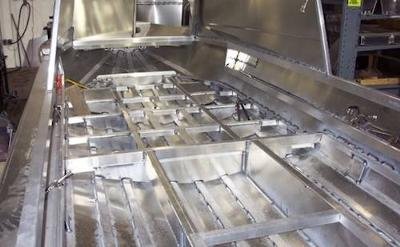Pros and Cons of Choosing An Aluminium or Fibreglass Boat
Fibreglass Versus Aluminium Boats
I have been asked on many occasions, which type of boat hull is best and I thought it would make the subject of an interesting article.
I have heard many a salty sea dog argue the toss over which makes the better hull. The problem is that pipe-smoking white-haired gentlemen have a tendency to passionately defend the style of boat they are familiar with, regardless of the competitor’s admirable qualities.
Therefore I have presented the facts below ‘sans’ emotion:
Firstly the advantages of aluminum:
Robustness – Having recently had a student back our fibreglass boat into the wharf and send splinters of fibreglass to the bottom of the bay, I appreciate the undeniable strength of an aluminium hull which would have probably come off better than the wharf. Aluminium bends, fiberglass breaks!
Weight – A lightweight hull requires less engine HP to push it through the water hence less $$. Lighter boats can also mean easier launching and recovering. However lightweight can also be a disadvantage (see below)
Disadvantages of aluminium:
Comfort – Light hulls can result in a noisy uncomfortable ride in choppy seas.
Handling – A lighter boat can feel less solid or planted during high-speed maneuvers.
Cost – Aluminium boats tend to be cheaper.
Repair – Small dents in aluminium hulls are easily repaired, however, when larger areas of damage occur it is difficult and costly to repair.
Corrosion – Aluminium hulls have been known to suffer in salt-water environments due to corrosion. You also need to be careful how your electrical connections and other metals touch the aluminium as they can react and corrode.
Cold – Aluminium boats tend to be colder than their counterparts as they conduct heat away quicker and can be more prone to condensation.
Anti-fouling – [For those who don’t know] Anti-foul is the paint on the bottom of boats that live in the water and helps prevent marine growth at the bottom of the boat. Anti-fouling an aluminium boat is harder and more expensive. Only really relevant for boats left in the water for long periods of time.
Advantages of Fiberglass:
Aesthetics – A fibreglass hull can be moulded into fancy shapes and sleek lines that an aluminium owner can only stand back and admire.
Repairs – It is easy to find people to repair fibreglass, also there are few minor accidents that a $15 tube of Epifill can’t sort out.
Maintenance – Fibreglass boats tend to require less hull maintenance and vigilance, there are no rivets, welds or corrosion to worry about.
Disadvantages of Fiberglass:
Flaws – Poor workmanship can be easily disguised on a fibreglass hull. Bubbles in fibreglass weaken the hull yet are impossible to detect on the inner layers.
Osmosis – Fiberglass hulls are susceptible to what is called osmosis. This is water being absorbed into the inner fibers resulting in the rotting of the material. This is normally caused by factory flaws and un-repaired damage to the gel coat (shiny outer layer of the hull) through which water can seep. Osmosis can be a serious problem if not treated promptly.
Wood Rot – Some Fiberglass boats use timber reinforcement parts such as cross-members. If water ever manages to find these parts the results can be expensive. Many modern manufacturing techniques do not require the use of timber components.
In conclusion, what may be one man’s pride may be another’s scorn. There is no right or wrong choice, just what works for you. I myself am a fibreglass convert but this may simply be because these are the types of boats I have grown up with, and haven’t had a lot to do with aluminium. They both float and fish aren’t too fussed about which type of boat they end up on!


